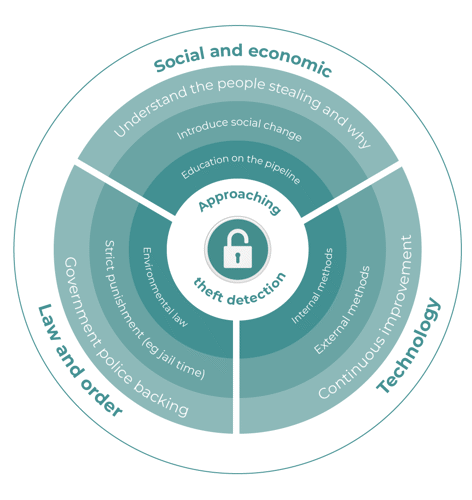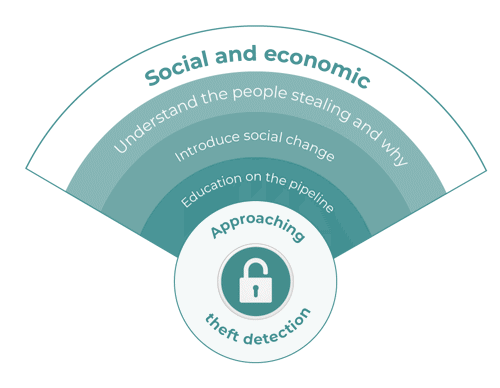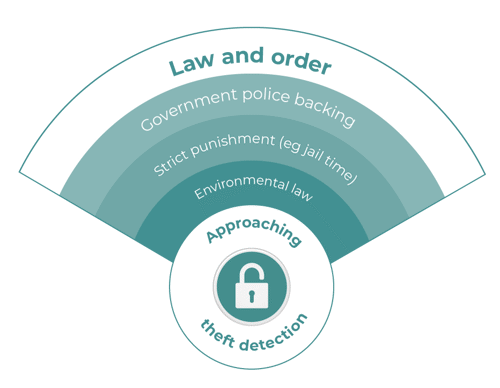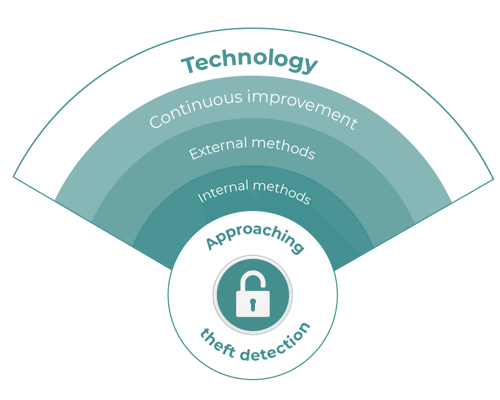The growing challenge of pipeline theft
Pipeline theft has always been a global problem, but as pipeline thieves become more experienced, the equipment they use is becoming more sophisticated and their methods more complex.
Because the causes for pipeline theft differ across the world, each region is impacted by the crime in a different way and some are more heavily impacted than others. For example:
- Africa estimates losses of around 115,000 oil barrels per day1
- In Asia, three million liters of fuel is smuggled daily from Malaysia to Thailand2
- A Mexican drug cartel can make around 90,000 USD in minutes just from pipeline tapping3
Atmos has detected over 1,000 pipeline thefts globally and as leaders in both leak and theft detection, we believe that a multilayered approach can effectively reduce theft activity, anywhere in the world.

But what do each of these layers mean? Here we’ll take a further look at the three point approach to reducing pipeline theft, including:
- Social & economic
- Law & order
- Technology
Social & economic

To successfully adopt a multilayered approach to pipeline theft detection, it’s vital to understand not only how thieves are stealing, but why they are stealing too.
Understand the people stealing and why
Pipeline theft in Latin American and African countries is driven by socioeconomic factors such as high unemployment rates and poverty. To add to this, pipelines can run through remote areas and have a weak infrastructure, which makes theft easier for opportunists.
In Asia and the Middle East, pipeline theft remains a popular organized crime due to fuel price in some countries being much higher than in others. This type of economic strain presents an opportunity for organized crime groups to smuggle fuel in and sell it at a reduced price.
Our global pipeline theft detection ebook delves further into regional specifics.
As well as motive, fundamental to a social approach to pipeline theft detection systems is understanding how criminals behave, which can be seen in the techniques they use.
One of the main fuel theft techniques used is the “slash and grab” approach which is less likely to be associated with organized crime groups and more generally driven by basic human needs for fuel, such as heating and cooking.
“Slash and grab” isn’t just limited to financial, property and reputational damage for pipeline operators, but there’s also a high risk of pipeline ruptures becoming exposed through poor installations.
Another common fuel theft technique is the “try and remain hidden” approach, where we typically see valves opening slowly over a few minutes and longer hoses being used.
Introduce social change
Organised crime groups are known for corrupting people who live or work close to pipelines. For example, Mexican drug cartels often use violence and threats to pressurize pipeline company workers to give them information that will help them steal the oil.
To overcome this challenge, social change initiatives can deter members of local communities from joining pipeline theft operations in the future.
We often see pipeline operators in these countries investing in education for the local communities and funding school activities. Additionally, educating communities on the subject of pipeline theft is another approach to reducing it.
Education on pipelines
To help prevent people close to a pipeline – whether it be residents or pipeline operators – from becoming involved in theft operations, initiatives such as pipeline education can be introduced to prevent the social side of pipeline theft.
For example, some pipeline operators work with local communities to educate them on the value of pipelines and prevent corrupting influences from creating more pipeline thieves in the area.
Law & Order

Pipeline theft is criminal by nature, but it can expose pipeline operators to strict punishment too. Illegal tapping points are often poorly crafted, leak product and present a risk of rupture.
The legal impact of pipeline theft can lead to the loss of millions of dollars in revenue each year due to safety breaches such as spills and explosions, resulting in fines and clean-up costs which can cost more than the product stolen by thieves.
For this reason, an approach that considers strict punishment for criminals, government police backing and environmental law should form part of a multilayered approach to pipeline theft, so that pipeline operators can mitigate the legal risk to themselves while ensuring criminals face the full extent of the law.
Government police backing
Fuel pipeline theft is a large operation and can even involve corrupt government officials and military personnel, who are bribed or threatened to turn a blind eye or have an active involvement.
To overcome this, some countries are currently implementing joint task forces and special security teams to patrol pipelines and provide extra layers of protection against theft.4
Strict punishment (eg jail time)
The government in places like Nigeria for example continue to pass further laws to deter pipeline thieves. Pipeline thieves in Latin American countries can be sentenced to up to 30 years in prison for installing illegal tapping points.1
Environmental law
Illegal tapping points can cause collateral damage to the environment if they turn into a leak, spill, rupture or explosion. This can place a pipeline at risk of breaking environmental laws, even though the damage isn’t caused by pipeline operators.
To protect the operation of a pipeline and its surrounding environment, an approach to theft detection that considers environmental law is vital, especially when theft and vandalism often occur on pipelines that run through remote locations because power and communications are limited.
In remote locations, a pipeline leak or rupture poses a greater threat to the environment and ecosystem because these could be high consequence areas (HCAs), so an environmental disaster caused by a pipeline leak becomes far more costly than the stolen product.
Remote areas at risk of breaking environmental laws through pipeline theft can be fitted with theft detection hardware solutions that can function offline.
For example Atmos Odin is a battery powered offline data acquisition unit designed to find pipeline product theft in locations with no power or communications. The unit’s small and inconspicuous size means it is difficult for thieves to see.
Technology

Technology is key for the success of a multilayered approach to theft detection to provide pipeline operators with the data they need and alerts when thefts occur.
Internal methods
Because the size and duration of each theft can be below the flow meter detection limit, it’s important to use elements from both volume balance and negative pressure wave (NPW) methods for detection. Solutions such as Atmos Wave Flow use both to reduce uncertainty and improve performance.
Effective pipeline theft detection technology must have the following three features:
- High sensitivity (detecting every small product withdrawal)
- Accurate leak location (accurately locating tapping points)
- Quick response (detecting product withdrawal as quickly as possible)
At Atmos, these features form part of our online technology and fixed and portable hardware solutions. This enables us to quickly collect and analyze accurate pipeline data, which is then analyzed by our in-house trained theft engineers.
Hardware innovation provides essential instrumentation which supports and complements theft detection systems. For example, Atmos Eclipse has a non-intrusive pressure sensor so it can provide straightforward measurement without having to connect to existing tapping points or create new ones, removing the need to drill, weld or cut the pipeline.
This is further supported by the Atmos Theft Net service. Our team of Atmos engineers are trained in the latest theft detection techniques to analyze the data in greater detail to locate the theft site to within meters. This human element adds superior accuracy while maintaining highly sensitive theft detection without the distraction of false alarms.
External methods
The internal methods can be supported by external methods of detection including physical line walks, sniffer dogs to smell out the chemicals leaking into the soil and terrain and the use of drones, helicopters, satellites and visual technology to survey pipelines quickly, particularly those in remote areas.
Fiber optic cables can be laid alongside the pipeline to detect the vibrations caused by human activities, and changes in the temperature and strain measurements in the event when a theft causes a leak. Distributed temperature sensing and distributed acoustic sensing are the two popular applications.
Continuous improvement
It’s common for product thieves to change their methods and locations to avoid detection. To evolve faster than thieves’ techniques, a technological approach to pipeline theft detection systems should be in a state of continuous improvement.
By detecting theft events happening all over the world our experts have access to this important information to better develop and enhance our offerings that help pipeline operators stay one step ahead.
How to take action now
Ultimately, to tackle pipeline theft detection systematically all parts of the multilayered approach need to be addressed. One aspect that pipeline operators can take immediate and proactive action with is the implementation of theft detection technology that is effective in detecting every theft event, providing an accurate leak location and responding quickly.
Pipeline operators may need to use a multi-method approach to theft detection by combining online technology with fixed and portable hardware solutions to collect and analyze pipeline data.
Implementing the technology alone will be effective for a certain period of time before thieves change their methods. That’s why it’s critical to work with a theft detection specialist who is innovative and continually evolving their technologies to counteract the ever changing challenges.
Learn more about Atmos’ theft detection solutions
Watch the video Download the ebook
References
1 https://www.tandfonline.com/doi/full/10.1080/17440572.2021.1925552
2 https://www.atmosi.com/en/resources/ebooks/global-pipeline-theft-detection-ebook/
3 https://oilmanmagazine.com/article/oil-theft-a-frightening-international-perspective/
4 https://www.energyintel.com/00000182-f9c0-d92d-a5b7-f9fcc5710000
